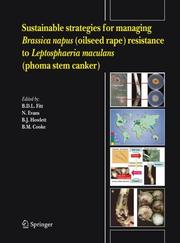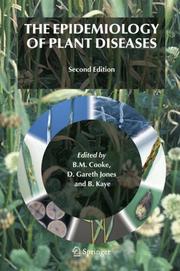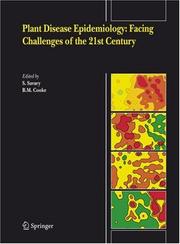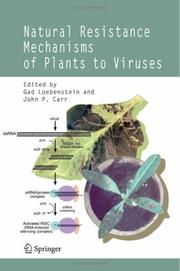| Listing 1 - 10 of 18 | << page >> |
Sort by
|
Dissertation
Abstract | Keywords | Export | Availability | Bookmark
 Loading...
Loading...Choose an application
- Reference Manager
- EndNote
- RefWorks (Direct export to RefWorks)
632.38 --- Virus diseases of plants --- Theses --- Sciences and engineering --- biological sciences --- agriculture --- plant pathology --- 632.38 Virus diseases of plants --- plant pathology. --- Tomatoes --- Crops --- Uganda --- Diseases and pests --- Tomato mosaic virus --- Leaves --- Food crops --- Biological sciences --- Agriculture --- Plant pathology.
Dissertation
Abstract | Keywords | Export | Availability | Bookmark
 Loading...
Loading...Choose an application
- Reference Manager
- EndNote
- RefWorks (Direct export to RefWorks)
632.4 --- 633.496 --- Algal and fungal diseases of plants. Plant mycoses etc. --- Yautia, tannia or coco-yam. Xanthosoma --- Theses --- Sciences and engineering --- biological sciences --- biology --- microbiology --- agriculture --- plant pathology --- 633.496 Yautia, tannia or coco-yam. Xanthosoma --- 632.4 Algal and fungal diseases of plants. Plant mycoses etc. --- microbiology. --- plant pathology. --- Xanthosoma sagittifolium --- Diseases and pests --- Cameroon --- Root crops --- Pythium myriotylum --- Biological control --- Phytopathogenic fungi --- Agricultural pests --- Xanthosoma sagittifolium root rot --- Biological sciences --- Agriculture --- Plant pathology. --- Biology --- Microbiology.

ISBN: 1280625066 9786610625062 1402045255 1402045247 9048171423 Year: 2006 Publisher: Dordrecht, The Netherlands : Springer,
Abstract | Keywords | Export | Availability | Bookmark
 Loading...
Loading...Choose an application
- Reference Manager
- EndNote
- RefWorks (Direct export to RefWorks)
The interaction between the fungus Leptosphaeria maculans and oilseed rape (Brassica napus) is becoming an excellent model system for studying genetics of host-pathogen interactions. Leptosphaeria maculans causes phoma stem canker (blackleg) on oilseed rape and other Brassica crops worldwide. Recently, application of molecular techniques has led to increased understanding of the genetics of this hemibiotrophic interaction. The complete sequences of the genomes of L. maculans and B. rapa (comprising the Brassica A genome) will be available soon. This will provide new opportunities to investigate basic metabolic pathways in the host and the pathogen, and detailed knowledge of the disease process. Worldwide, the major strategy for control of phoma stem canker is the use of cultivars with resistance to L. maculans. However, serious epidemics have occurred recently in Australia and Europe when L. maculans populations changed such that major gene resistance in oilseed rape was overcome. Thus there is an urgent need to find and deploy sources of resistance to L. maculans in a manner that enhances their durability. This book provides researchers with a synthesis of the recent studies relating to strategies for management of resistance genes to provide effective control of L. maculans, and will stimulate further research on this important model system.
Rape (Plant) --- Brassica --- Leptosphaeria --- Disease and pest resistance --- Genetic aspects --- Genetics --- Breeding --- Pleosporaceae --- Cruciferae --- Brassica napus --- Brassica napus napobrassica --- Colza --- Winter rape --- Plant diseases. --- Botany. --- Agriculture. --- Plant Pathology. --- Plant Sciences. --- Botanical science --- Phytobiology --- Phytography --- Phytology --- Plant biology --- Plant science --- Biology --- Natural history --- Plants --- Botany --- Communicable diseases in plants --- Crop diseases --- Crops --- Diseases of plants --- Microbial diseases in plants --- Pathological botany --- Pathology, Vegetable --- Phytopathology --- Plant pathology --- Vegetable pathology --- Agricultural pests --- Crop losses --- Diseased plants --- Phytopathogenic microorganisms --- Plant pathologists --- Plant quarantine --- Farming --- Husbandry --- Industrial arts --- Life sciences --- Food supply --- Land use, Rural --- Pathology --- Diseases and pests --- Diseases --- Wounds and injuries --- Plant pathology. --- Plant science. --- Floristic botany

ISBN: 1402045816 1402045794 1402045808 Year: 2006 Publisher: Dordrecht : Springer Netherlands : Imprint: Springer,
Abstract | Keywords | Export | Availability | Bookmark
 Loading...
Loading...Choose an application
- Reference Manager
- EndNote
- RefWorks (Direct export to RefWorks)
Plant disease epidemiology is a dynamic science that forms an essential part of the study of plant pathology. This book brings together a team of 35 international experts. Each chapter deals with an essential component of the subject and allows the reader to fully understand how each exerts its influence on the progress of pathogen populations in plant populations over a defined time scale. Since the first edition of the text was published in 1998, many new developments have occurred in the subjects covered, particularly molecular diagnostics, modelling, fungicide resistance and information technology. The second edition of the book is a comprehensive text on all aspects of plant disease epidemiology that should serve as an invaluable reference work for those involved in this fascinating science of crop plants.
Plant diseases --- Epidemiology. --- Plant disease epidemiology --- Plant epidemiology --- Plant epiphytology --- Epidemiology --- Host parasite relations --- Biological competition --- Laboratory diagnosis --- Models --- Pesticide resistance --- Disease surveillance --- Plant diseases. --- Botany. --- Agriculture. --- Plant Pathology. --- Plant Sciences. --- Farming --- Husbandry --- Industrial arts --- Life sciences --- Food supply --- Land use, Rural --- Botanical science --- Phytobiology --- Phytography --- Phytology --- Plant biology --- Plant science --- Biology --- Natural history --- Plants --- Botany --- Communicable diseases in plants --- Crop diseases --- Crops --- Diseases of plants --- Microbial diseases in plants --- Pathological botany --- Pathology, Vegetable --- Phytopathology --- Plant pathology --- Vegetable pathology --- Agricultural pests --- Crop losses --- Diseased plants --- Phytopathogenic microorganisms --- Plant pathologists --- Plant quarantine --- Pathology --- Diseases and pests --- Diseases --- Wounds and injuries --- Life sciences. --- Plant pathology. --- Plant science. --- Floristic botany

ISBN: 1281140627 9786611140625 1402050208 1402050194 9048172578 Year: 2006 Publisher: Dordrecht, The Netherlands : Springer,
Abstract | Keywords | Export | Availability | Bookmark
 Loading...
Loading...Choose an application
- Reference Manager
- EndNote
- RefWorks (Direct export to RefWorks)
Plant disease epidemiology deals with diseases in plant populations. During the past century, it has become a vibrant field of science, achieving significant conceptual innovations with an important impact on the management of plant diseases. Plant disease epidemiology mobilises concepts and methods from ecology, genetics, environmental physics, botany, and mathematics. It deals with cultivated and non-cultivated plants in environments where human activities may have had an impact. Now, plant disease epidemiology faces important questions. Global climate is changing at a rapid rate: will it render plant diseases more, or less, harmful to man-made ecosystems? There is much debate on this issue, partly because climate has sometimes very large effects on the local environment of growing plant canopies, and because the physical micro-environment so strongly influences plant diseases and their consequences on ecosystem functioning and performance and the way they are managed. Plant disease epidemiologists have a strong scientific tradition in studying climate-pathogen-disease relationships. Biodiversity is also of global concern. The decline of global biodiversity that is currently taking place has been referred to as the sixth great extinction process our planet has experienced during its history, but this time, it is man-made. Generations of plant pathologists, and especially, of plant disease epidemiologists, have been dealing with biodiversity. It is from this diversity that presumably the most potent instrument for disease management has been developed by plant pathologists: host plant resistance. Host plant diversity, and the disease resistance genes it harbours, can be deployed over time and space, according to epidemiological principles. Sustainable production and protection systems also need to be devised which could exploit scarcer resources sparingly, and if possible enhance the resource base. Plant disease epidemiologists alone cannot provide answers to such questions, but certainly could significantly contribute to these new strategies. This book provides an overview of some of the latest research in plant disease epidemiology from researchers at the cutting edge of this important discipline. Reprinted from European Journal of Plant Pathology, Volume 115, No. 1, 2006.
Plant diseases --- Epidemiology. --- Plant disease epidemiology --- Plant epidemiology --- Plant epiphytology --- Epidemiology --- Botany. --- Plant diseases. --- Agriculture. --- Plant Sciences. --- Plant Pathology. --- Farming --- Husbandry --- Industrial arts --- Life sciences --- Food supply --- Land use, Rural --- Botany --- Communicable diseases in plants --- Crop diseases --- Crops --- Diseases of plants --- Microbial diseases in plants --- Pathological botany --- Pathology, Vegetable --- Phytopathology --- Plant pathology --- Plants --- Vegetable pathology --- Agricultural pests --- Crop losses --- Diseased plants --- Phytopathogenic microorganisms --- Plant pathologists --- Plant quarantine --- Botanical science --- Phytobiology --- Phytography --- Phytology --- Plant biology --- Plant science --- Biology --- Natural history --- Pathology --- Diseases and pests --- Diseases --- Wounds and injuries --- Plant science. --- Plant pathology. --- Floristic botany
Book
ISBN: 1280803649 9786610803644 1402051646 Year: 2006 Publisher: Dordrecht : Springer,
Abstract | Keywords | Export | Availability | Bookmark
 Loading...
Loading...Choose an application
- Reference Manager
- EndNote
- RefWorks (Direct export to RefWorks)
These are just a few examples that illustrate the chemical diversity and use of phenolic compounds, the topic of ‘Phenolic Compound Biochemistry’. This book is written for researchers, instructors, advanced undergraduate students and beginning graduate students in the life sciences who wish to become more familiar with these and many other intriguing aspects of phenolic compounds. Topics covered include nomenclature, chemical properties, biosynthesis, including an up-to-date overview of the genetics controlling phenolic metabolism, isolation and characterization of phenolic compounds, phenolics used in plant defense, and the impact of phenolics on human health. The book is written in an accessible style, and assumes only basic knowledge of organic chemistry, biochemistry and cell physiology. More than 300 chemical structures and reaction schemes illustrate the text. Wilfred Vermerris is Associate Professor of Agronomy at the University of Florida Genetics Institute in Gainesville, FL. His research focuses on the genetic control of phenolic compounds that impact agro-industrial processing of crop plants. Ralph Nicholson is Professor of Botany and Plant Pathology at Purdue University in West Lafayette, IN. He is an expert on phenolic compounds involved in the plant’s defense against pathogenic fungi and bacteria.
Phenols. --- Biochemistry. --- Biological chemistry --- Chemical composition of organisms --- Organisms --- Physiological chemistry --- Biology --- Chemistry --- Medical sciences --- Phenolic compounds --- Phenolics --- Alcohols --- Antiseptics --- Aromatic compounds --- Composition --- Plant diseases. --- Botany. --- Biochemistry, general. --- Plant Pathology. --- Plant Sciences. --- Botanical science --- Phytobiology --- Phytography --- Phytology --- Plant biology --- Plant science --- Natural history --- Plants --- Botany --- Communicable diseases in plants --- Crop diseases --- Crops --- Diseases of plants --- Microbial diseases in plants --- Pathological botany --- Pathology, Vegetable --- Phytopathology --- Plant pathology --- Vegetable pathology --- Agricultural pests --- Crop losses --- Diseased plants --- Phytopathogenic microorganisms --- Plant pathologists --- Plant quarantine --- Pathology --- Diseases and pests --- Diseases --- Wounds and injuries --- Plant pathology. --- Plant science. --- Floristic botany
Book
ISBN: 0387232664 9781281334466 1281334464 Year: 2006 Publisher: New York, NY : Springer US : Imprint: Springer,
Abstract | Keywords | Export | Availability | Bookmark
 Loading...
Loading...Choose an application
- Reference Manager
- EndNote
- RefWorks (Direct export to RefWorks)
This comprehensive volume consists of a series of up-to-date reviews, each incorporating current models and knowledge related to mechanisms of resistance either expressed constitutively or induced systemically in plants. Each chapter covers a topic related to the phenomenon of plant resistance to fungal and bacterial pathogens, insects, nematodes, viruses or abiotic stress in plants, as well as the application of this knowledge to protect crops now and in the future. Researchers, upper-level undergraduate and graduate students, and those teaching courses in plant physiology, entomology and plant pathology will find this volume a much needed asset. Featured Topics include: QTL analysis of multigenic disease resistance in plant breeding Ultrastructural studies in plant disease resistance Chemical signals in plant resistance: salicylic acid Signaling in plant resistance responses: divergence and cross-talk of defense pathways Tree defenses against insects Chemical signals in plants: jasmonates and the role of insect-derived elicitors in responses to herbivores Engineering plants for durable disease resistance Commercialization of plant systemic defense activation: theory, problems and successes.
Plants --- Plant genetics. --- Disease and pest resistance. --- Genetics --- Disease resistance of plants --- Immunity (Plants) --- Pest resistance of plants --- Resistance of plants to disease --- Resistance of plants to pests --- Plant defenses --- Plant immunology --- Immunity --- Pest resistance --- Hardiness --- Plant diseases. --- Botany. --- Biochemistry. --- Agriculture. --- Plant Ecology. --- Plant Pathology. --- Plant Sciences. --- Plant Biochemistry. --- Plant Genetics and Genomics. --- Farming --- Husbandry --- Industrial arts --- Life sciences --- Food supply --- Land use, Rural --- Biological chemistry --- Chemical composition of organisms --- Organisms --- Physiological chemistry --- Biology --- Chemistry --- Medical sciences --- Botanical science --- Phytobiology --- Phytography --- Phytology --- Plant biology --- Plant science --- Natural history --- Botany --- Communicable diseases in plants --- Crop diseases --- Crops --- Diseases of plants --- Microbial diseases in plants --- Pathological botany --- Pathology, Vegetable --- Phytopathology --- Plant pathology --- Vegetable pathology --- Agricultural pests --- Crop losses --- Diseased plants --- Phytopathogenic microorganisms --- Plant pathologists --- Plant quarantine --- Ecology --- Composition --- Pathology --- Diseases and pests --- Diseases --- Wounds and injuries --- Phytoecology --- Vegetation ecology --- Plant pathology. --- Plant science. --- Plant biochemistry. --- Plant ecology. --- Floristic botany --- Phytochemistry --- Plant biochemistry --- Plant chemistry --- Biochemistry --- Phytochemicals --- Plant biochemical genetics --- Floristic ecology

ISBN: 1280800216 9786610800216 0387302530 0387302522 Year: 2006 Publisher: Dordrecht : Springer,
Abstract | Keywords | Export | Availability | Bookmark
 Loading...
Loading...Choose an application
- Reference Manager
- EndNote
- RefWorks (Direct export to RefWorks)
The Air Spora is an illustrated guide to trapping, identifying and quantifying airborne biological particles such as fungus and plant spores and pollen. This book will be of use to anyone interested in aerobiology or studying applied aspects such as dispersal and effect of allergens, or human, animal and plant pathogens. Including a comprehensive review of what is in the air and detailing the historical development of theories leading to modern aerobiology, the book explains the fundamental processes behind airborne dispersal and techniques used to sample, identify and quantify biological particles. Methods are explained in a step-by-step guide for the use of standard air sampling devices. Although formats applicable to modern molecular and immunological techniques are described, the emphasis of the book is on simple visual identification of particles in air samples using traditional microscopy. Consequently a chapter on setting-up and using a light microscope is included, although experienced researchers can skip to chapters showing photographs of examples of the Air Spora and nine colour plates of paintings of airborne particles at a magnification of x1000. "I recommend this book to those actively running or thinking of running a pollen and spore trapping program. It will also be of value to doctors, allergists, and those teaching the basics of palynology, wishing to include a lecture or two on air spora." David M. Jarzen, Florida Museum of Natural History In: The Newsletter of the American Association Of Stratigraphic Palynologists, 2007(40:2).
Air --- Pollen --- Plant spores. --- Fungi --- Microbiology. --- Collection and preservation. --- Grains, Pollen --- Pollen grains --- Pollinaria --- Anther --- Palynology --- Pollination --- Aerobiology --- Aeromicrobiology --- Microbiology --- Plants --- Spores (Botany) --- Plant cells and tissues --- Spores --- Bacteriology --- Reproduction --- Plant diseases. --- Immunology. --- Botany. --- Microscopy. --- Allergy. --- Plant Pathology. --- Plant Sciences. --- Biological Microscopy. --- Allergology. --- Microbial biology --- Biology --- Microorganisms --- Allergic diseases --- Allergies --- Hypersensitivity --- Hypersensitivity, Immediate --- Immediate allergy --- Immediate hypersensitivity --- Immunologic diseases --- Immunoglobulin E --- Analysis, Microscopic --- Light microscopy --- Micrographic analysis --- Microscope and microscopy --- Microscopic analysis --- Optical microscopy --- Optics --- Botanical science --- Phytobiology --- Phytography --- Phytology --- Plant biology --- Plant science --- Natural history --- Immunobiology --- Life sciences --- Serology --- Botany --- Communicable diseases in plants --- Crop diseases --- Crops --- Diseases of plants --- Microbial diseases in plants --- Pathological botany --- Pathology, Vegetable --- Phytopathology --- Plant pathology --- Vegetable pathology --- Agricultural pests --- Crop losses --- Diseased plants --- Phytopathogenic microorganisms --- Plant pathologists --- Plant quarantine --- Pathology --- Diseases and pests --- Diseases --- Wounds and injuries --- Plant pathology. --- Plant science. --- Floristic botany
Book
ISBN: 1280624345 9786610624348 1402036949 Year: 2006 Volume: 6 Publisher: Dordrecht : Springer,
Abstract | Keywords | Export | Availability | Bookmark
 Loading...
Loading...Choose an application
- Reference Manager
- EndNote
- RefWorks (Direct export to RefWorks)
It is my privilege to contribute the foreword for this unique volume entitled: “Plant Tissue Culture Engineering,” edited by S. Dutta Gupta and Y. Ibaraki. While there have been a number of volumes published regarding the basic methods and applications of plant tissue and cell culture technologies, and even considerable attention provided to bioreactor design, relatively little attention has been afforded to the engineering principles that have emerged as critical contributions to the commercial applications of plant biotechnologies. This volume, “Plant Tissue Culture Engineering,” signals a turning point: the recognition that this specialized field of plant science must be integrated with engineering principles in order to develop efficient, cost effective, and large scale applications of these technologies. I am most impressed with the organization of this volume, and the extensive list of chapters contributed by expert authors from around the world who are leading the emergence of this interdisciplinary enterprise. The editors are to be commended for their skilful crafting of this important volume. The first two parts provide the basic information that is relevant to the field as a whole, the following two parts elaborate on these principles, and the last part elaborates on specific technologies or applications.
Plant tissue culture. --- Plant biotechnology. --- Crop biotechnology --- Crops --- Plants --- Agricultural biotechnology --- Tissue culture --- Biotechnology --- Botany. --- Cytology. --- Biology --- Developmental biology. --- Plant anatomy. --- Plant diseases. --- Plant Sciences. --- Cell Biology. --- Computer Appl. in Life Sciences. --- Developmental Biology. --- Plant Anatomy/Development. --- Plant Pathology. --- Data processing. --- Botany --- Communicable diseases in plants --- Crop diseases --- Diseases of plants --- Microbial diseases in plants --- Pathological botany --- Pathology, Vegetable --- Phytopathology --- Plant pathology --- Vegetable pathology --- Agricultural pests --- Crop losses --- Diseased plants --- Phytopathogenic microorganisms --- Plant pathologists --- Plant quarantine --- Plant structure --- Structural botany --- Vegetable anatomy --- Anatomy --- Development (Biology) --- Growth --- Ontogeny --- Cell biology --- Cellular biology --- Cells --- Cytologists --- Botanical science --- Phytobiology --- Phytography --- Phytology --- Plant biology --- Plant science --- Natural history --- Pathology --- Diseases and pests --- Diseases --- Wounds and injuries --- Structure --- Plant science. --- Cell biology. --- Bioinformatics . --- Computational biology . --- Plant development. --- Plant pathology. --- Development of plants --- Plant development --- Developmental biology --- Growth (Plants) --- Bioinformatics --- Bio-informatics --- Biological informatics --- Information science --- Computational biology --- Systems biology --- Data processing --- Floristic botany

ISBN: 1280902469 9786610902460 1402037805 1402037791 9048169631 Year: 2006 Publisher: Dordrecht : Springer,
Abstract | Keywords | Export | Availability | Bookmark
 Loading...
Loading...Choose an application
- Reference Manager
- EndNote
- RefWorks (Direct export to RefWorks)
Over the course of evolution most plants have acquired the ability to defend themselves against most groups of pathogens, including the viruses. Many antiviral resistance phenomena have been known and studied for decades but, until recently, understanding of their underlying mechanisms has lagged behind. These phenomena include resistance to infection, resistance to virus translocation through the plant, recovery from infection and genetically defined resistance, together with the associated phenomena of the local lesion response, and induced, or acquired, resistance. The identification and cloning of plant resistance genes, characterization of downstream signaling components, and especially the explosion of data regarding gene-silencing mechanisms, has led to rapid progress in the investigation of natural resistance phenomena. Meanwhile, in plant virology there has been remarkable progress in the arenas of replication, movement proteins and plasmodesmatal gating, and in the discovery of gene silencing suppressors. Therefore, it seemed timely and appropriate to link older but still important data on the well known, ‘classical’ resistance phenomena with the new information that has emerged during the last decade or so. We hope that this book will inspire further research in this area, as resistance presents the most economical and environmentally sound approach to control plant virus diseases. Future technologies that emerge from this research might include an improved ability to introduce resistance genes into virus-susceptible, agronomically important cultivars, to improve current pathogen-derived resistance strategies using our new knowledge of small interfering and microRNAs, or to develop targeted chemical treatments.
Plants --- Virus diseases of plants. --- Virus resistance. --- Plant virus diseases --- Plant diseases --- Plant viruses --- Plant resistance to viruses --- Resistance of plants to viruses --- Viral resistance in plants --- Virus resistance in plants --- Virus diseases --- Disease and pest resistance --- Host plants --- Botany. --- Agriculture. --- Plant diseases. --- Plant Sciences. --- Plant Pathology. --- Farming --- Husbandry --- Industrial arts --- Life sciences --- Food supply --- Land use, Rural --- Botanical science --- Phytobiology --- Phytography --- Phytology --- Plant biology --- Plant science --- Biology --- Natural history --- Botany --- Communicable diseases in plants --- Crop diseases --- Crops --- Diseases of plants --- Microbial diseases in plants --- Pathological botany --- Pathology, Vegetable --- Phytopathology --- Plant pathology --- Vegetable pathology --- Agricultural pests --- Crop losses --- Diseased plants --- Phytopathogenic microorganisms --- Plant pathologists --- Plant quarantine --- Pathology --- Diseases and pests --- Diseases --- Wounds and injuries --- Plant science. --- Plant pathology. --- Floristic botany
| Listing 1 - 10 of 18 | << page >> |
Sort by
|

 Search
Search Feedback
Feedback About UniCat
About UniCat  Help
Help News
News